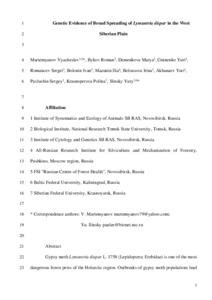Показать сокращенную информацию
Genetic Evidence of Broad Spreading of Lymantria dispar in the West Siberian Plain
| Автор | Vyacheslav, Martemyanov | |
| Автор | Roman, Bykov | |
| Автор | Marya, Demenkova | |
| Автор | Yuri, Gninenko | |
| Автор | Sergei, Romancev | |
| Автор | Ivan, Bolonin | |
| Автор | Ilia, Mazunin | |
| Автор | Irina, Belousova | |
| Автор | Yuri, Akhanaev | |
| Автор | Sergey, Pavlushin | |
| Автор | Polina, Krasnoperova | |
| Автор | Yury, Ilinsky | |
| Дата внесения | 2020-01-20T08:01:38Z | |
| Дата, когда ресурс стал доступен | 2020-01-20T08:01:38Z | |
| Дата публикации | 2019-08 | |
| Библиографическое описание | Vyacheslav, Martemyanov. Genetic Evidence of Broad Spreading of Lymantria dispar in the West Siberian Plain [Текст] / Martemyanov Vyacheslav, Bykov Roman, Demenkova Marya, Gninenko Yuri, Romancev Sergei, Bolonin Ivan, Mazunin Ilia, Belousova Irina, Akhanaev Yuri, Pavlushin Sergey, Krasnoperova Polina, Ilinsky Yury // PLoS ONE. — 2019. — 14(8). | |
| ISSN | 19326203 | |
| URI (для ссылок/цитирований) | https://journals.plos.org/plosone/article?id=10.1371/journal.pone.0220954 | |
| URI (для ссылок/цитирований) | https://elib.sfu-kras.ru/handle/2311/129579 | |
| Аннотация | Gypsy moth Lymantria dispar L. 1758 (Lepidoptera: Erebidae) is one of the most dangerous forest pests of the Holarctic region. Outbreaks of gypsy moth populations lead to significant defoliation of local forests. Within the vast territory of the West Siberian Plain, we noted the outbreak front movement of in the north-east direction with a speed 100-200 km per year. The reason for the outbreak’s movement is still unclear because L. dispar females are characterised by limited flight ability, which is not enough to support that movement per se. Herein, we analysed the mtDNA divergence pattern among L. dispar populations collected from the vast territory of the West Siberian Plain to determine the boundaries of populations and reveal the effect of the outbreak’s front movement on mtDNA patterns of populations. The 590-bp region of the cytochrome oxidase subunit I gene of the mitochondrial genome was sequenced for 220 specimens that were collected from 18 localities along a transect line (~ 1400 km). Our results clearly show that the gypsy moth populations of the vast Siberian territory are not subdivided. This result can be explained by extensive genetic exchange among local populations. Taking into account that the flight ability of L. dispar females is rather limited, we suggest that spreading occurs through ballooning of early instar larvae. This hypothesis was confirmed by the coincidence of the outbreaks’ movement direction with that of the dominant winds, complemented by the observation of ballooned larvae far from a forest edge. | |
| Название | Genetic Evidence of Broad Spreading of Lymantria dispar in the West Siberian Plain | |
| Тип | Journal Article | |
| Тип | Journal Article Preprint | |
| ГРНТИ | 34.35 | |
| Дата обновления | 2020-01-20T08:01:38Z | |
| Институт | Институт экологии и географии | |
| Подразделение | Кафедра экологии и природопользования | |
| Журнал | PLoS ONE | |
| Квартиль журнала в Scopus | Q1 | |
| Квартиль журнала в Web of Science | Q1 |

